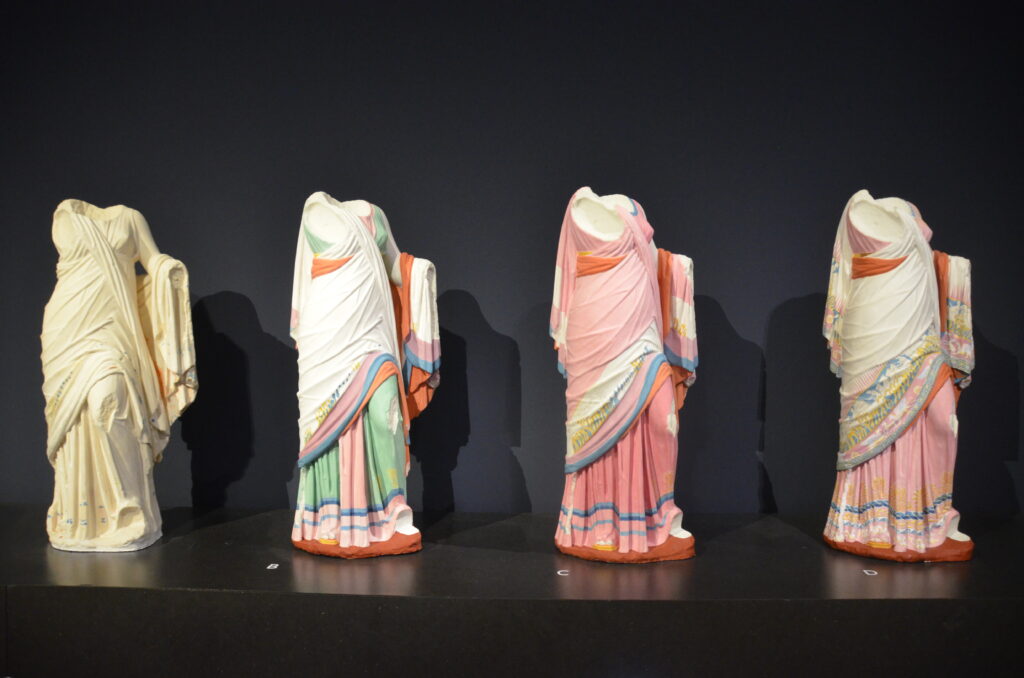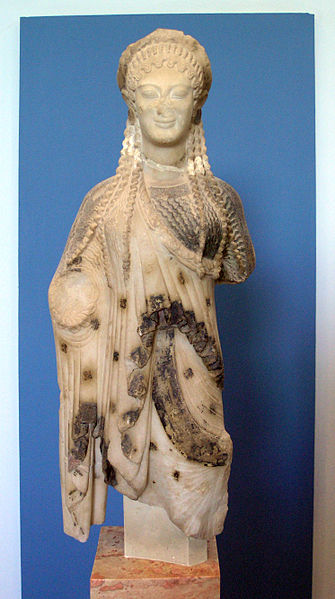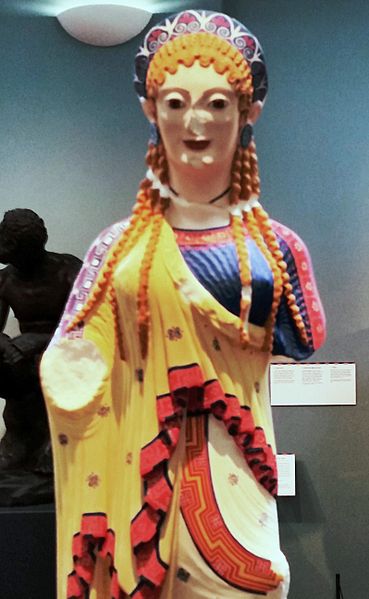When people imagine ancient Greece and Rome, they picture pristine white marble sculptures. Images of Greek and Roman society in media and art museums exhibit and perpetuate the idea of undecorated, glistening white marble statues and buildings. As a result, most people don’t have an accurate perception of what the ancient world really looked like. Dating back to the 18th century, the value of marble and its white aesthetic has been presented to the public by historians, classicists, and archaeologists, despite archaeological evidence and scholarly consensus on the existence of polychromy in ancient art.
“Polychromy” is Greek for many-colored. It can apply to just about anything. In this project, we focused on the existence of polychromy on Greek and Roman sculpture. This is because Greek and Roman sculpture was originally brightly painted.
Sculpture in the ancient world was not plain stone. Rather, it was painted in many bright colors. Today, ancient sculpture is often misleadingly displayed without any reference to the color it once had. To counter the narrative of white marble sculpture, the Coloring the Past project integrates digital technologies and projection mapping to illustrate a possible reconstruction of the two plaster casts of marble relief sculpture in the Rhys Carpenter Library at Bryn Mawr College. This non-invasive, non-destructive method allows for the illumination of the reliefs with an animated color layer to show what they would have looked like in antiquity.
Aims of the Project
Coloring the Past aims to accomplish 3 things:
1. To present knowledge of polychromy to the wider Bryn Mawr audience, using projection mapping on plaster casts in Carpenter Library to temporarily alter their appearance.
2. To create a more inclusive space in the library and open channels for new conversations about diversity, colorism, and history which have been silenced by the absence of color.
3. To showcase the potential of incorporating a multi-disciplinary approach to presenting ancient art to the broader community.
Understanding that the Greek and Roman world was colorful is an easy-to-swallow way to get people to question their preconceptions about the perceived homogeneity of Greek and Roman societies. Since important parts of modern Western culture base themselves on the most elite parts of Greek and Roman culture—for example Athenian democracy—we’re hoping that by habituating people with images of polychrome sculptures, we can paint the ancient world as a diverse, colorful place.
All sculpture was not white
The knowledge that Greek and Roman sculptures were originally painted has been described as the best kept secret that was never really a secret. Since the 18th century, archaeologists and travelers observed and recorded traces of paint on sculptures. Evidence for ancient polychromy was widespread in scholarly articles and watercolor paintings dating back over a century, which depict sculptures and reliefs with their original colors, much of which has now faded off.

Johann Winckelmann, an influential art historian from the mid-18th century, perpetuated this misrepresentation. Identified as the father of art history, Winkelmann wrote his seminal work Geschichte der Kunst des Alterthums (1764) which serves as the foundation for our understanding of Greek art. In it, Winckelmann celebrates the whiteness of the Apollo Belvedere as a paragon of beauty (Bond 2017, “Why We Need…”). However, his later writings suggest that “[his] thinking was evolving, and that he might eventually have embraced polychromy, had he not died in 1768, at the age of fifty” (Talbot, 2018). Yet belief in the aesthetic beauty and superiority of white marble persists.
Despite the evidence that Greek and Roman sculptures were painted, bedazzled, accessorized, and gilded, the image of white marble sculpture is widespread and ideas to the contrary are met with resistance and condemnation (Rose-Greenland 2016).
The absence of color has resulted in fatal misconceptions of the ancient world which have been misused and misappropriated by radical groups. Take for example the alt-right group Identity Evropa. In 2016, this group targeted campuses with posters of sculptures like the Apollo Belvedere and Nicolas Coustou’s Julius Caesar with phrases such as “Protect Your Heritage,” “Our Future Belongs to Us,” and “Let’s Become Great Again.” In “Classics and the Alt-Right: Historicizing Visual Rhetorics of White Supremacy” Heide Morse notes that these posters drew on the iconicity and cultural capital of the sculptures as an overt appeal to a supposedly “white” classical tradition linked to white European heritage (Morse 2018). But we know from extensive polychromy research analyzing traces of paint that these statues were colorfully painted and may represent a wide variety of ethnic groups within ancient societies.
In antiquity, references to painted sculpture appear in many different media. One wall painting from the House of the Surgeon in Pompeii depicts a female painter with a figure painting and a polychrome statue before her. A 4th century krater shows an artist painting a statue of Heracles. Many ancient authors describe how color can “finish” a work of art. In Euripides’ Helen, the tragically beautiful titular character wishes she could be wiped clean like a statue, exemplifying how the ancients saw an unpainted statue as less beautiful than one that was painted (Bradley 2009, 437).

Illuminating the past using projection mapping

To debunk the myth of “whiteness” of Greek and Roman sculpture and provide imaginative access to an image of the ancient world that is more accurately colorful, the Coloring the Past project used non-destructive digital technologies to create a sensory viewing experience. Projection mapping uses the art object as the canvas for displaying images or videos. In Coloring the Past, we chose to implement this technique on two plaster casts, the Borgia stele and Nike adjusting her sandal, located in the Digital Media and Collaboration Lab in Rhys Carpenter Library, the archaeology, classics, architecture and art history library at Bryn Mawr College. Prior to this project, these casts were exhibited as white surfaces, perpetuating the myth of undecorated sculpture. Projection mapping allows us to visualize a hypothetical reconstruction of the original painted surface of the Borgia stele and Nike adjusting her sandal by projecting color onto their surfaces, without altering or damaging the actual casts. It also allows multiple color scheme to be showcased. Digital reconstructions and projection mapping projects have become a popular alternative to the more labor-intensive physical reconstructions, for example the painstaking work by Vinzenz Brinkmann and Ulrike Koch-Brinkman’s hand-painted plaster casts for the Gods in Color exhibition that toured throughout North America and Europe.
The different methods of reconstruction have their strengths and weaknesses. Physical reconstructions are a powerful visual aid and allow for live experimentation with the physical properties of the object, like surface material and paint composition. Digital reconstructions, however, are more accessible, and easier to change. Coloring the Past has some of the strengths of both approaches, but in the actual projection, the texture of the reconstruction may be lost, so we encourage you to examine the online reconstructions as well.
Go to the Reconstruction of the Borgia stele
Go to the Reconstruction of the Sandalbinder

